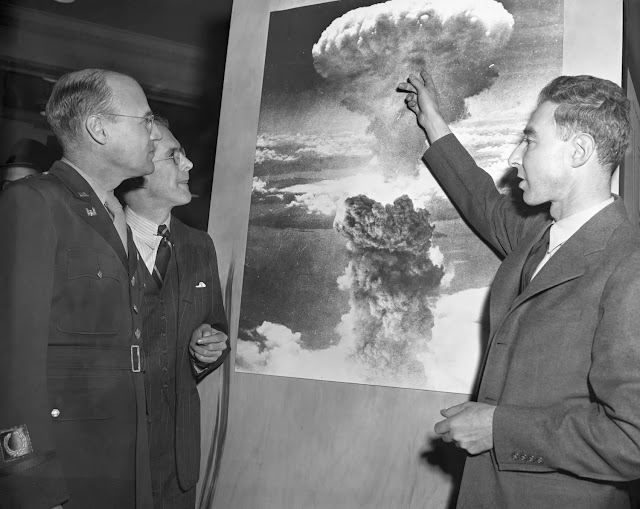The Trinity Test: The Birth of the Atomic Age
 |
Introduction
This weekend marks the release of the highly anticipated Oppenheimer movie, which has everyone buzzing about the history of the Manhattan Project and the dawn of the atomic age. While the movie is generating a lot of attention, I want to take a moment to focus on a pivotal event that often doesn't get as much spotlight—the Trinity Test. This groundbreaking test was the first successful detonation of an atomic bomb, and it played a crucial role in shaping the course of history. Join me as we delve into the story of Trinity, the location, the people behind it, and the immense efforts that went into its success.
Trinity: The Journey of the Dead Man
Trinity, the code name for the test, took place on July 16, 1945, in the desolate desert of New Mexico, specifically at a site called Jornada del Muerto, which translates to the Journey of the Dead Man in Spanish—an eerily fitting name given the significance of the events that unfolded there. The location was chosen due to its remote, uninhabited nature and its proximity to the scientists and engineers working on the Manhattan Project.
The Trinity site was part of the Alamogordo bombing range and had been acquired by the U.S. government in 1942. Prior to the test, the residents were relocated, and the area became a hub of scientific and engineering activity. The only building on the Trinity site was the McDonald ranch house, which was transformed into a laboratory for assembling the hardware needed for the bomb.
The Role of Jumbo
One fascinating aspect of the Trinity test was the creation of a massive steel container named Jumbo. The primary purpose of Jumbo was to contain the force of a conventional explosion in case the implosion of the bomb failed. This was to prevent the plutonium—the most valuable component of the bomb—from being scattered across the desert if the bomb didn't detonate as intended. Although Jumbo was never used in the actual test, its presence highlighted the meticulous planning and contingency measures involved in such a high-stakes project.
The Unsung Heroes
While Oppenheimer often takes center stage in discussions of the Manhattan Project, it's essential to recognize that the success of Trinity and subsequent atomic tests was a collective effort involving numerous scientists, engineers, and technicians. One key figure in making Trinity work was George Kistiakowsky, a chemist originally from Ukraine. He was tasked with perfecting the implosion system and played a crucial role in refining the explosive lens system. Kistiakowsky's ingenuity, hands-on leadership, and attention to detail were instrumental in overcoming challenges and ensuring the bomb's success.
Overcoming Obstacles
The implosion system faced numerous obstacles, including quality control issues with the explosives. Imperfections in the explosive blocks could disrupt the precision needed for a successful implosion. To tackle this problem, Kistiakowsky took matters into his own hands, using a dentist drill to manually correct imperfections in the explosives, ensuring they met the required standards.
The Spark Gap Initiator
 |
| US3956658-1 Donald Hornig- Spark Gap Switch Patent Diagram |
Another vital component of the Trinity test was the spark gap initiator, a technology developed by Harold Edgerton, a pioneer in photography and high-speed imaging. The spark gap initiator was used to trigger the detonation of the bomb's explosives with precise timing. Edgerton's expertise in flash photography and triggering mechanisms proved invaluable in the development of this crucial component.
The Trinity Test
 |
| The Gadget – the world’s first atomic bomb – is an implosion-style plutonium weapon that was tested at the Trinity test in the New Mexico desert on July 16, 1945. |
Despite initial concerns about the detonators, the Trinity test proceeded as planned on July 16, 1945. The bomb, code-named Gadget, was assembled, and the countdown to the momentous event began. The blast yielded approximately 25 kilotons of explosive power, surpassing the yields of previous nuclear tests.
Legacy of Trinity
 |
| The Manhattan Project developed the world's first atomic bombs. Here, a mushroom cloud rises from the first atomic explosion, detonated on July 16, 1945, in Alamogordo, New Mexico. |
The success of the Trinity test paved the way for the use of atomic bombs during World War II. It also marked the beginning of the nuclear age, forever altering the course of history and raising profound ethical and moral questions about the use of such powerful weapons. The scientific advancements made during the Manhattan Project had far-reaching implications beyond warfare, shaping the fields of physics, chemistry, and engineering for years to come.
Coda:
As we reflect on the Trinity test, we are reminded of the immense dedication and sacrifice of the individuals involved in the Manhattan Project. Their groundbreaking work in nuclear science and technology brought about a new era in human history—one that would forever change the world. The legacy of Trinity serves as a stark reminder of the tremendous power and responsibility that comes with scientific discoveries, urging us to use knowledge for the betterment of humanity rather than destruction.





No comments:
Post a Comment